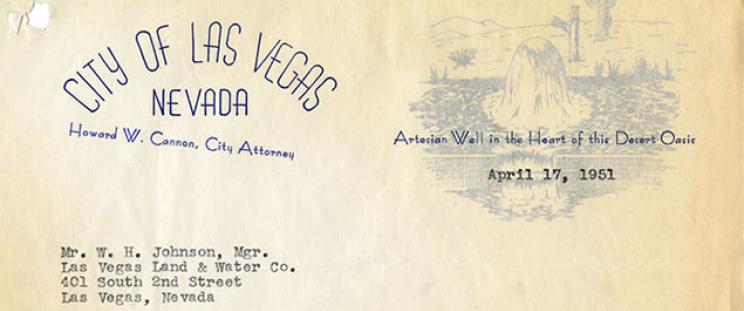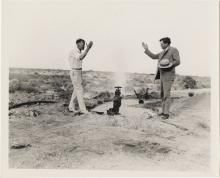Collection Paragraphs

While the Las Vegas Springs enabled the railroad to establish a community in the Las Vegas Valley, it was still a community in a desert. The railroad owned the rights to, and controlled access to, all the water from the springs, and fiercely defended any encroachments on that water. So the discovery that drilling elsewhere in the valley could produce a heavy artesian flow set off a gold rush for water. Many believed that artesian water was inexhaustible, and even though Nevada’s water laws dictated that all water must be appropriated to beneficial use, many well-owners let their wells run freely rather than cap them and conserve the flow.

Because customer water meters were prohibited by state law, there was no mechanism for controlling an individual user’s water consumption. The profligate domestic use of water contributed to Las Vegas becoming the highest per-capita user of water in the state. Water usage increased even more when individuals and businesses began installing evaporative coolers.
The City of Las Vegas, which for a time proudly pictured a freely flowing artesian well on its letterhead, occasionally passed ordinances prohibiting the waste of water or proscribing lawn watering during certain times of the day. During particularly acute shortages, the police department would assign officers to enforce watering restrictions. Attempts by the Water Company to restrict water usage either by city ordinance or through the use of water meters were bitterly opposed by many in the city who accused the company of attempting to maximize its profits by limiting the amount of water it was willing to supply. As Las Vegas Review-Journal editor A. E. Cahlan commented on one of the Water Company’s many efforts to repeal the state law prohibiting water meters, “The threat of the use of meters is solely because of the hope of increased revenue with no improvement in service.”
“. . . chances are the principal cause of lack of pressure is the prodigal use of water in the town for irrigating purposes, etc., a situation which is very difficult to control . . . I am very skeptical of the advisability of purchasing somebody else’s wells . . . “
J.Ross Clark to W.H. Comstock, letter, May 25, 1920
Inquiry:
Knickerbocker states: "If we are unable to reasonably regulate the consumption of water, then it only means that the more there is available, the greater the consumption per capita will be . . ." What pre-1950 evidence exists to substantiate and refute his claim in terms of both public and private water uses?
“There is an abundance of water available for all the needs in the town of Las Vegas, if some reasonable effort is made to conserve it and to shut off sprinkling during the day time”
F.N. Knickerbocker to Walter Bracken, letter, July 8, 1935
“ . . . The decrease in production of water at Las Vegas is more or less disturbing. It seems to me that fact alone presents one of the strongest arguments you can make with the city officials, newspaper men, etc., as a reason and necessity for conserving water . . . I suggest you keep hammering away on the matter in Las Vegas, and I am sure you are bound to get some results. If we are unable to reasonably regulate the consumption of water, then it only means that the more there is available, the greater the consumption per capita will be . . . “
Knickerbocker to Bracken, letter, June 25, 1936
Inquiry:
Reverse-engineer air conditioners of the 1930s. Given only technology available at the time, what alternative designs might have proven more environmentally friendly, particularly in terms of water conservation and waste? What factors may have negated or supported use of these alternative designs?
“ . . . there is a prodigal use of water, particularly during the heated term when very high temperatures prevail. The low water pressure resulting from the gravity system . . . has a bearing upon the waste observable in sprinkling lawns; another removable item of loss has been seen in negligent operation of air conditioning apparatus, of which there is much in the city. From time to time the attention of the public has been directed by advertisements in the city newspapers to the waste of water by consumers, and such educational work will, it is hoped, produce lasting results. There is a city ordinance relating to the wasteful use of water, passed in July, 1939 but it has not been enforced . . .”
There has been a great deal of waste of water in the Las Vegas Valley, and in considerable measure this conditions persists. Until the wood stave pipes which quite recently underlaying the principal part of the city and several of its platted additions were replaced with cast iron pipe, the constantly recurring leaks in the mains accounted for a considerable loss of water both visible and annoying to the townspeople. Under the circumstances it must have been difficult to obtain serious regard to the company’s reiterated complaints concerning citizens who leave their lawn hose running all day and operate air conditioning devices with continuous streams of water throughout their waking hours.”
W.H. Hulsizer, Manager of Properties, UP, Omaha, Report on the Las Vegas Nevada Water Supply, March 25, 1942
Inquiry:
Analyze the locations of wells and their available acre-feet of water in the Las Vegas Valley during the 1940s. Considering geographic conditions such as soils, aquifer volumes, and average annual precipitation, what would constitute sustainable use of groundwater resources? How would this translate into private, public, and agricultural uses?
“Locally , much of the excessive decline of water levels in Las Vegas Valley has been a result of local overdevelopment caused by close spacing and heavy pumping of wells. However, the available data indicate that ground water probably is now being pumped from storage; that is more water is being taken from the reservoirs than is entering them from the recharge areas, and that therefore part of the water-level decline has resulted from over pumping. Thus, continued withdrawal of substantially more than 35,000 acre-feet of ground water annually will result in continued, and possibly increasing, decline of the water level and in overdevelopment of the ground-water supply in Las Vegas Valley.”
Maxey and Jameson, Geology and Water resources of Las Vegas, Pahrump, and Indian Spring Valleys, Clark and Nye Counties, Nevada, 1948
